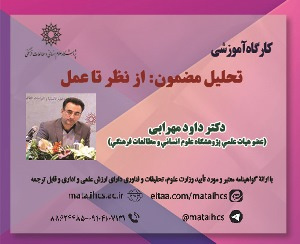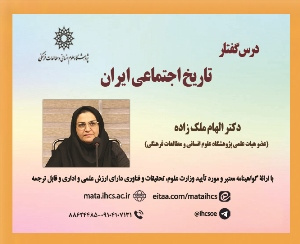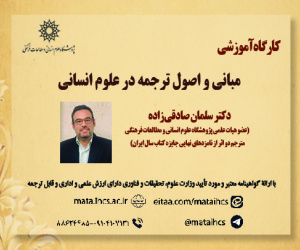بررسی بن مایه ستایش ایزدان در کتیبه های پیش از اسلام (به زبان های فارسی باستان و فارسی میانه)
آرشیو
چکیده
کتیبه ها، به سنگ نوشته هایی گفته می شود که منابع بازمانده از زبان و خط ایران باستان است. از لحاظ خط و تنوع زبانی (پارسی باستان، عیلامی، بابلی) کتیبه های هخامنشی از برجسته ترین کتیبه های بر جای مانده است. نگارندگان کتیبه ها معمولاً واقعه تاریخی یا پیام پادشاه وقت را د ر آن حک می کردند تا در برابر دید عموم مردم قرار بگیرد. شاخص ترین مشخصه کتیبه های مربوط به دوره هخامنشی و ساسانیان (فارسی میانه) ستایش اهورامزدا و یاری های او و ذکر سلطنت است. از آنجا که پژوهشگران زبان فارسی چندان به ستایش در کتیبه ها نپرداخته اند و جای خالی آن در پژوهش های زبان فارسی احساس می شود، ما در این جستار بر آن هستیم تا با مطالعه چندین کتیبه از دوره های یاد شده به بررسی ستایش اهورامزدا در آن ها بپردازیم. فرض ما بر این است که بنا بر کتیبه های متعدد از دوره هخامنشی، بسامد ستایش در این کتیبه ها بیشتر از سایر کتیبه ها است. روش تحقیق ما در این پژوهش به صورت تحلیلی توصیفی و کتابخانه ای است.Investigation of the theme of praise of gods in pre-Islamic inscriptions (in Old Persian and Middle Persian)
1. Introduction
Inscriptions are written and carved documents on the bodies of stones and on the doors of buildings that testify to the longevity of ancient Iran and the extent and justice of its kings.The first inscriptions remain from the Achaemenid period, which are written in ancient Persian, Elamite and Babylonian languages and in cuneiform script, which has caused the invention of cuneiform script to be attributed to Great Darioush. Among the famous Achaemenid inscriptions, we can mention the inscriptions of Ariarmene, Arshame, Korosh II, Darioush I, Khashayarsha, Ardashir I and others.
The praise of gods from the ancient past has remained in the prose and poetry of ancient Iran; which is used at the beginning of the speech and in prefaces. Most of the praises are enumerating the glory and majesty of Gods and recognizing them as pure from any impurity that without their help, victory cannot be achieved. The same points are more visible in the surviving stone inscriptions from the Achaemenid period. As Dariush considers his successive conquests in the help and will of Ahura Mazda.
According to our hypothesis, the name of Ahuramazda is more frequent in Achaemenid inscriptions, and the main reason for this is that Achaemenid inscriptions are more numerous than Sasanian inscriptions. The ancient Persian alphabet was derived from the Akkadian alphabet and the Akkadian alphabet was derived from the Sumerian alphabet. This alphabet has thirty-six letters and two separating words with eight adjectives for the concepts of Bagh (God), Deh (Country), Bom (Land), King, Earth, Ahuramazda (in active and passive).
Research Methodology
By studying several inscriptions from the mentioned periods, he investigated the praise of Ahura Mazda in them; Accordingly, this research is based on a library study and descriptive-analytical method.
Discuss
Achaemenid inscriptions are extensive and include columns with different lines. These inscriptions are often written in three cuneiform scripts (Old Persian, Babylonian and Elamite). The contents of praise in this period of inscriptions are as follows:
Help: In the inscriptions left from the Achaemenid period, the kings attributed all their great works to the help and favor of Ahura Mazda. And Ahura Mazda has been praised as the greatest gods, the helper of the judge, the eternal god who always brings happiness and comfort to man; Greatness: The glory and greatness of Ahura Mazda is mentioned; Will: refers to mentioning the will of Ahura Mazda in all matters; Reward and forgiveness: It refers to any kind of giving and awesomeness of Ahura Mazda; Creator: Creation has always been with Ahura Mazda and is as ancient as Ahura Mazda; Religious need from Ahura Mazda and other gods: In Achaemenid inscriptions, in addition to praise, Achaemenid kings asked for their religious needs from Ahura Mazda and other gods.
In the Sasanian inscriptions, these things are also discussed: Multiple deities: refers to multiple gods; Support: God's support for a person is less mentioned in the inscriptions than other topics; Prostration to Ahura Mazda: refers to praying to Ahura Mazda; Religious need: Religious need in inscriptions has been a fluid issue in inscription writing, as it was also examined in Achaemenid inscriptions. Yarigar: Asking God for help in various matters.
Conclusion
Based on the investigations of the Achaemenid and Sasanian era inscriptions, it was found that the praise of Ahuramazda is more in the inscriptions of Achaemenid kings and Dariush Shah is the most praised among other kings. The frequency of praise in Achaemenid inscriptions is six attributes, and in these six attributes, traces of other attributes can be observed, which overlap. In the inscriptions of the Sasanian era, this number has been reduced to five adjectives.


